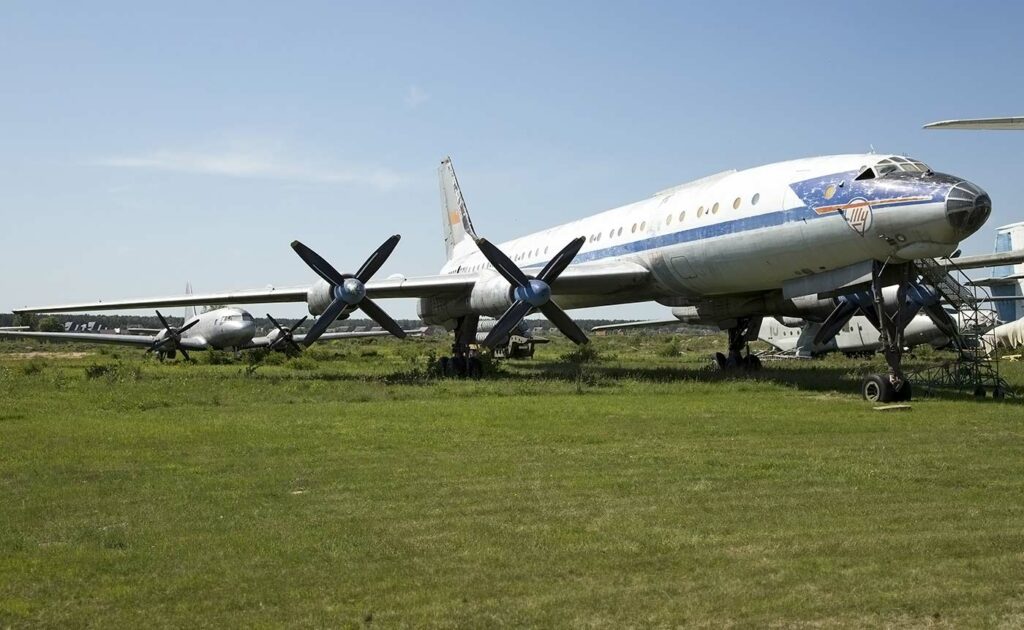The Tupolev Tu-126 (Moss) was a Soviet AWACS aircraft, pivotal for airborne early warning and control, adapted from the Tu-114 airliner.
In Brief
The Tupolev Tu-126 (Moss) was the Soviet Union’s first airborne early warning and control (AEW&C) aircraft, entering service in the 1960s. Based on the Tupolev Tu-114 airliner, it was equipped with extensive radar systems, notably the Liana surveillance radar, housed in a large rotodome above the fuselage. The Tu-126 was designed to provide long-range radar surveillance and airborne command and control, significantly enhancing the Soviet Union’s defensive and offensive air capabilities. It featured four powerful turboprop engines, enabling extended endurance and a broad operational range. Despite its advancements, the Tu-126 was eventually supplanted by more modern technology but served as a critical step in developing Soviet AEW&C capabilities.
The Tupolev Tu-126 (Moss) marked a significant milestone in Soviet aviation, being the first aircraft specifically designed for the AEW&C role, enhancing the USSR’s airborne surveillance and strategic command capabilities.
History of the Development of the Tupolev Tu-126 (Moss)
In the context of the Cold War, the Soviet Union urgently needed a robust airborne early warning and control (AEW&C) system to counter the growing threat of Western strategic bombers and to enhance its own air defense and offensive capabilities. The development of the Tu-126 was initiated to fill this gap, adapting the reliable Tupolev Tu-114 airliner to carry sophisticated radar equipment for long-range surveillance.
The program was launched by the Tupolev design bureau, with the primary objective of creating an aircraft capable of detecting enemy aircraft at great distances, thereby providing early warning and enhancing the command and control of Soviet air forces. The Tu-126 first flew in January 1962, demonstrating the Soviet Union’s growing technological prowess in aviation.
NATO assigned the nickname “Moss” to the Tu-126, following its protocol of codenaming Soviet aircraft for identification and tracking purposes. This name became synonymous with Soviet AEW&C efforts during the period it was in service.
Design of the Tupolev Tu-126 (Moss)
The Tu-126 was essentially a militarized version of the Tu-114, retaining much of its airframe and the robust turboprop propulsion system, featuring four Kuznetsov NK-12 engines, the most powerful turboprops ever built. The major design modification was the addition of a large rotodome above the fuselage, housing the Liana surveillance radar, which provided 360-degree coverage and could track multiple targets simultaneously.
The aircraft’s design emphasized endurance and range, necessary for prolonged surveillance missions. It was equipped with extensive communication systems to serve as a flying command post, relaying information between ground controllers and Soviet air forces.
However, the adaptation of a civilian airliner to a military role came with drawbacks. The Tu-126 was large and lacked the agility of purpose-built military aircraft. Additionally, its radar and electronic systems, while advanced for their time, quickly became outdated compared to emerging technologies.

Performance of the Tupolev Tu-126 (Moss)
The Tu-126 Moss offered robust performance as an AEW&C platform. Its four NK-12MV turboprop engines, each delivering 15,000 shaft horsepower, enabled the aircraft to cruise at speeds up to 770 km/h (478 mph) and reach a maximum altitude of 12,000 meters (39,370 feet). The aircraft’s range was approximately 6,500 kilometers (4,039 miles), allowing for extended-duration missions and wide-area surveillance.
In comparison to its Western counterparts like the EC-121 Warning Star or the later E-3 Sentry, the Tu-126 was less technologically sophisticated but served its purpose effectively, providing the Soviet Union with a significant strategic asset. Its operational performance was a crucial element in the Soviet military’s ability to monitor NATO aircraft movements and enhance their situational awareness.
Variants of the Tupolev Tu-126 (Moss)
The Tu-126 was produced primarily in a single variant, with no significant sub-variants documented. The design remained relatively consistent throughout its service life, focusing on the primary mission of airborne early warning and control.
Military Use and Combat of the Tupolev Tu-126 (Moss)
The Tu-126 Moss played a vital role in Soviet air defense strategy, serving from the 1960s to the 1980s. It was primarily used for long-range surveillance, early warning, and command and control, significantly enhancing the Soviet Union’s capability to detect and intercept hostile aircraft before they could pose a threat to Soviet airspace.
The aircraft did not engage directly in combat; instead, its value was in strategic reconnaissance and airborne command, contributing to the deterrence posture during the Cold War. Its intelligence-gathering capability was instrumental in several military operations and exercises, providing crucial data that informed Soviet military strategy.
The Tupolev Tu-126 Moss was a pivotal platform in the evolution of AEW&C aircraft, setting a foundation that would influence future designs and capabilities in airborne surveillance. Despite its limitations and eventual replacement by more advanced systems, the Tu-126 played a crucial role in enhancing the Soviet Union’s aerial detection and command capabilities, representing a significant period in military aviation history where airborne early warning systems became integral to national defense strategies.
Back to the Special Aircraft section